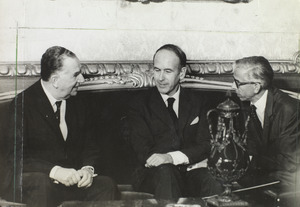Emílio Garrastazu Médici facts for kids
Quick facts for kids
Emílio Garrastazu Médici
GColTE GColSE
|
|
|---|---|
 |
|
| President of Brazil | |
| In office 30 October 1969 – 15 March 1974 |
|
| Vice President | Augusto Rademaker |
| Preceded by | Military Junta (interim) |
| Succeeded by | Ernesto Geisel |
| Head of the National Intelligence Service | |
| In office 17 March 1967 – 28 March 1969 |
|
| President | Artur da Costa e Silva |
| Preceded by | Golbery do Couto e Silva |
| Succeeded by | Carlos Alberto da Fontoura |
| Personal details | |
| Born | 4 December 1905 Bagé, Rio Grande do Sul, Brazil |
| Died | 9 October 1985 (aged 79) Rio de Janeiro, Brazil |
| Resting place | São João Batista Cemetery, Rio de Janeiro, Brazil |
| Political party | ARENA |
| Spouse | Scylla Nogueira |
| Children | 2 |
| Alma mater | Military School of Realengo |
| Profession | Military |
| Signature | |
| Military service | |
| Allegiance | |
| Branch/service | |
| Years of service | 1927–1969 |
| Rank | Army General |
| Commands |
|
| Battles/wars |
|
Emílio Garrastazu Médici (born December 4, 1905 – died October 9, 1985) was a Brazilian military leader. He also became a politician. He served as the president of Brazil from 1969 to 1974. His time as president was part of a period when the military had strong control over Brazil.
Contents
Early Life and Military Career
Médici was born in Bagé, a city in the Rio Grande do Sul state of Brazil. His family had roots from Italy and the Basque region. In the 1920s, he joined a military school in Porto Alegre. He then became part of the Brazilian Army. He was promoted steadily through the ranks. By 1961, he had become a general.
During the 1950s, Médici commanded reserve forces. Later, he worked as a chief of staff for Artur da Costa e Silva. This was from 1957 to 1960. After a military change in government in 1964, Médici served in the USA. He was Brazil's military representative there until 1966. In 1967, he was chosen to lead Brazil's National Intelligence Service.
Presidency (1969–1974)
In 1969, Médici became the commander of the Third Army. Soon after, a group of military leaders chose him to be the President of Brazil. He took over from Costa e Silva, who had become ill. The National Congress, Brazil's main law-making body, officially elected him. He was the only candidate.
Médici became president on October 30, 1969. He served until March 15, 1974.
Governing Brazil
Médici governed Brazil using a special set of rules from 1967. These rules gave the government a lot of power. During his presidency, the government had strict control over what people could say or publish. It also limited some civil rights. The government watched people who disagreed with its policies.
Médici's government also created special areas for Indigenous people.
Economic Growth
Médici's time as president saw a huge growth in Brazil's economy. This period is often called the "Brazilian Miracle". The economy grew very fast, about 10% each year. Prices also stayed fairly stable. Brazil even won the 1970 Football World Cup during this time!
In 1971, Médici introduced a plan to help the economy grow even more. This plan especially focused on the Northeast and Amazon basin regions. Many large building projects were started. These included the Trans-Amazonian Highway, the Itaipu Dam, and the Rio–Niterói bridge.
However, this economic growth mostly helped the richer people. By 1970, the official minimum wage was quite low. Many workers found their buying power had decreased compared to earlier years.
Elections and Successor
In November 1970, elections were held for federal, state, and city positions. Most of the winners were from the ARENA party. This party supported the military government. In 1974, another general, Ernesto Geisel, took over as president after Médici.
International Relations
Médici also met with leaders from other countries. In 1971, he met with U.S. President Richard Nixon at the White House. They talked about different topics, including the situation in other South American countries.

Médici also met with Valéry Giscard d'Estaing, who was then France's Minister of Economy and Finance. He later became the president of France. These meetings helped Brazil connect with other nations.
After the Presidency
After leaving the presidency on March 15, 1974, Médici stepped away from public life. He did speak out against a political pardon that happened in 1979.
Death
Emílio Garrastazu Médici passed away on October 9, 1985. He was 79 years old. He died from kidney failure after having a stroke. His burial place is the São João Batista Cemetery in Rio de Janeiro.
Honours
Foreign Honours
 Grand Collar of the Military Order of Saint James of the Sword (April 24, 1972)
Grand Collar of the Military Order of Saint James of the Sword (April 24, 1972) Grand Collar of the Order of the Tower and Sword (May 9, 1973)
Grand Collar of the Order of the Tower and Sword (May 9, 1973)
See also
- Brazilian military government
- Brazilian Miracle
- Araguaia Guerrilla War
 In Spanish: Emílio Garrastazu Médici para niños
In Spanish: Emílio Garrastazu Médici para niños



